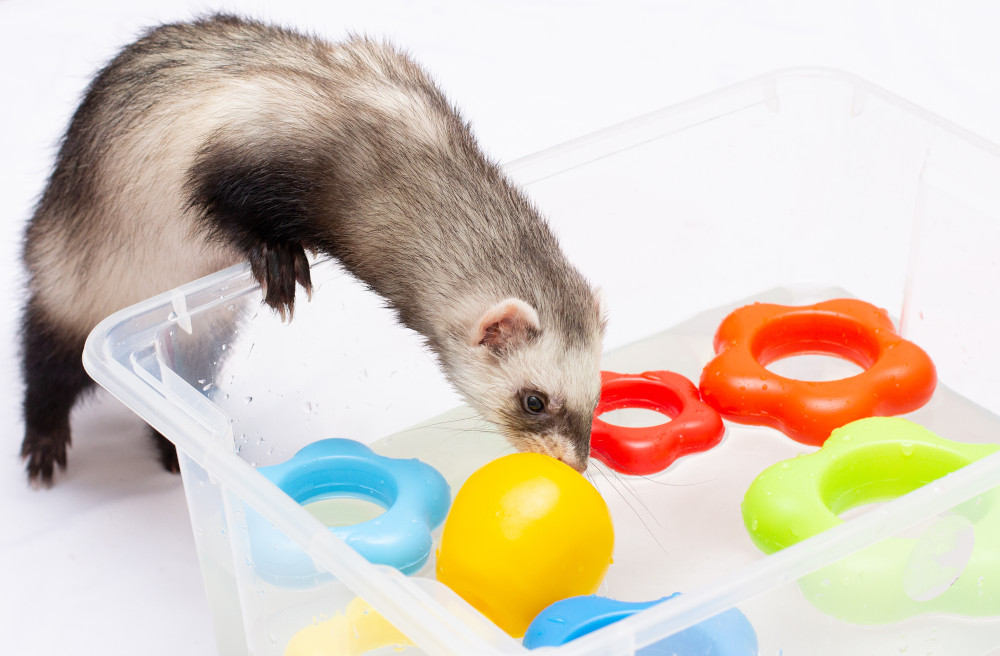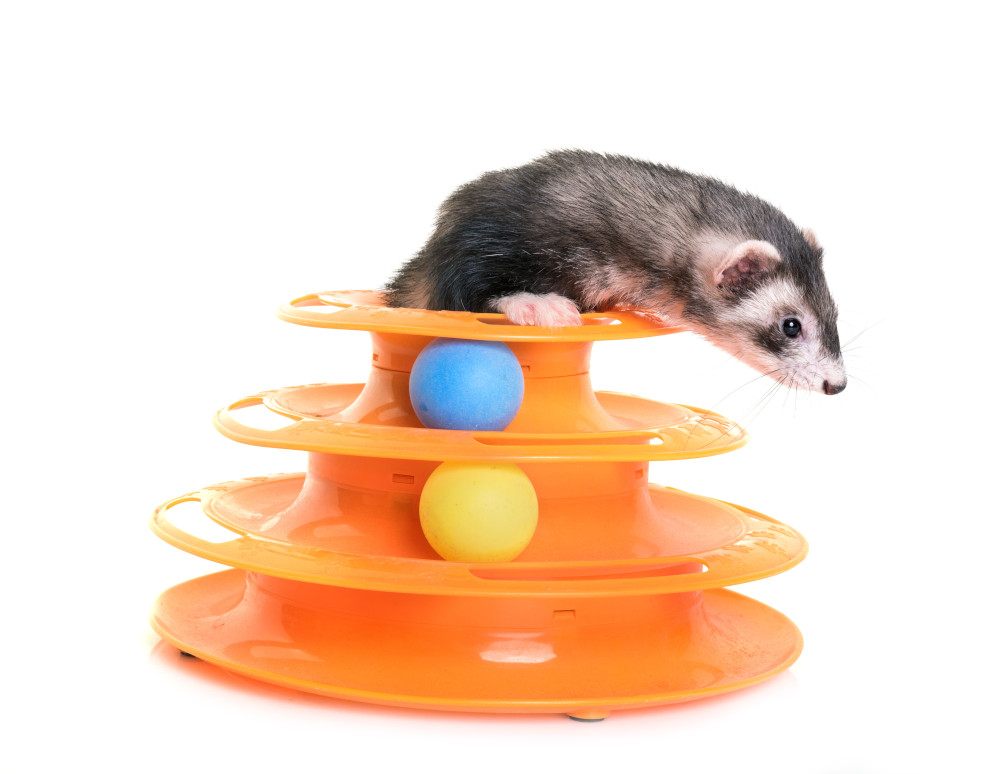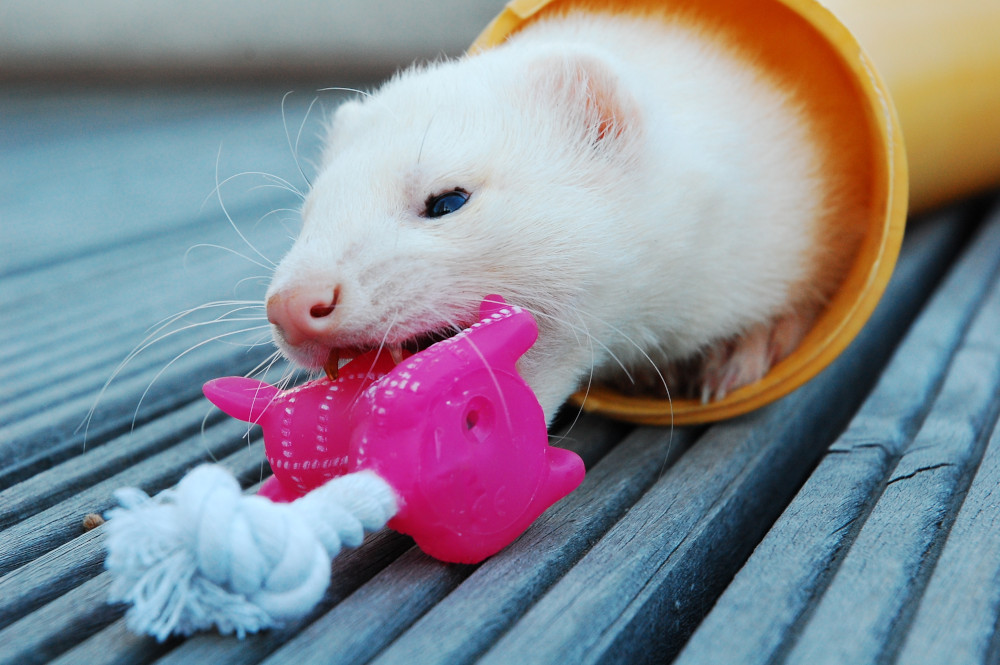How can I use environmental enrichment to provide opportunities for my ferrets to experience good welfare?
What is environmental enrichment?
Environmental enrichment describes the provision of physical and social opportunities to promote ferret behaviour that is important, valuable, and specific to them. It encourages and allows ferrets to do things that matter to them, resulting in positive experiences based on their individual interests, which underpins good animal welfare.
A key concept in environmental enrichment requires is that we know what ferrets like to do, also referred to as ‘species‐typical’ information. Then we can select enriching strategies that are behaviourally relevant and physically feasible for the ferret. Designing an enrichment plan that is incompatible with the animals’ normal behaviour, physical attributes or their existing environment may not improve their wellbeing and could also cause frustration and potential harm.
So, what is a ferret’s normal daily behaviour?
The ferret is the result of humans crossbreeding two species of polecat and has been domesticated for over 2,000 years. This makes it difficult to refer to their natural history, beyond considering information about polecats, feral ferrets, and polecat‐ferret hybrids.
Feral ferrets in Europe live in dens such as rabbit burrows but spend a large proportion of their active time travelling and foraging around their territory. The size of their territory is determined by their sex, age, and the abundance of prey in the area. Feral ferrets are solitary animals, except for breeding and before weaning. Their territories generally exclude other ferrets of the same sex, although territories of opposite sexes may overlap extensively. Ferrets use scent marking from anal gland secretions, faeces, and urine to obtain information on other individuals’ identity, reproductive, and social status.
Domestication has changed some of these characteristics – ferrets have evolved into a more diurnal (active in the daytime) and social animal and are less territorial – but they still prefer mixed-sex social groups, and they still scent mark their (much smaller) territory. Even though they are more diurnal than feral ferrets, they will still sleep approximately 12-16 hours in each 24 hour period, and sometimes up to 20 hours! Their foraging and hunting instincts prompt them to explore their environment, and they enjoy exploring tunnel systems that resemble the rabbit warrens their wild counterparts like to live in.
The type of behaviour exhibited by ferrets varies according to their individual interests, the type of environment, the age and sex of the ferrets, and their reproductive status.
Environmental enrichment should commence while your ferrets are still young, so that they can experience good welfare. Providing good environmental enrichment can also help to prevent potential health and behavioural issues stemming from an inadequate environment.
What happens if we don’t provide good environmental enrichment?
Animals who can express species‐specific behaviours, and have choice, control, and problem-solving opportunities are more likely to experience good welfare. Because they are physically and mentally challenged in positive ways, they are less likely to feel frustrated or display abnormal behaviours. Ferrets who are not having positive experiences and/or are having negative experiences, may display a range of abnormal or irrelevant behaviours, including:
- Changes in their activity levels
- Lethargy and sleeping more
- Hiding more than usual
- Avoiding interaction with their companions and/or people
- Changes in body language
- Tense and hunched over with flattened ears and wide eyes
- Arched back and a fluffed tail
- Loss of interest in food
- Vomiting or diarrhoea
- Aggression
- Hissing or growling
- Biting
- Excessive grooming resulting in hair loss or changes in fur texture
If your ferret is showing indications that they are not experiencing good welfare in the conditions they are living in, and your ferret-savvy veterinarian has ruled out a health problem, then you need to re-evaluate their environment and your environmental enrichment plan.
What makes for good environmental enrichment?
There is a tendency to think that environmental enrichment means just providing some toys or other distractions. This is only a small part of the process. An enrichment plan should include some or all of the following:
- Foraging enrichment
- Physical enrichment
- Sensory enrichment
- Social enrichment
- Occupational enrichment
Foraging enrichment
Foraging is the act of searching for and finding food. As mentioned earlier, healthy ferrets can sleep much of the day but, when awake, they are inquisitive and active, just like their wild (feral) counterparts who spend much of their awake time searching for food. Foraging therefore has great social and behavioural importance but is one of the most severely constrained classes of behaviour in captive ferrets; obviously there are potential implications of this common behavioural deficit for ferret welfare. Given that we know ferrets engage in four basic behaviours daily – foraging, socialising, grooming, and resting – removing the ability to forage (by feeding the same food in the same bowl at the same time) leaves a gaping hole that has to be filled with the other behaviours. A ferret who does not have the ability to forage may start to show signs of stress and poor welfare such as over-grooming or sleeping excessively, especially if the ferret lives alone without other ferrets to socialise with.
Foraging enrichment seeks to provide the animal with the opportunity to perform the normal species-specific behaviour of foraging and prevent or treat problems associated with behavioural restriction. It requires the ferret(s) to find food, chew, and sort through, manipulate and/or open objects to get to food, or even dig to find food. It should reflect the ferret’s natural foraging behaviour (e.g., food has to be actively sought and obtained) and can be increased in complexity as the ferret’s skill levels increase. This food should be part of, and not in addition to, their normal daily amount of food to prevent them gaining excessive weight. Dietary preferences are set by the time a ferret is four months old; offering a wide diversity of food choices before four months old can make foraging enrichment much easier in the future.
Examples of foraging behaviour can include:
- Foraging balls containing treats that your ferret must manipulate to extract the treat.
- Placing treats in a foraging box – a tray filled with wooden blocks your ferret must dig through to reach their reward.
- Placing treats in egg containers with a small hole cut in the top for the ferret to extend.
- Placing a treat in a large paper shopping bag and close off the end, leaving only a small hole.


Physical enrichment
Physical enrichment ranges from objects placed in the ferret’s environment (such as toys, tubes, tunnels, etc.) to the environment as a whole (e.g., the space available for the ferret to engage in locomotory behaviours such as running or hopping, or providing platforms and ladders). This is where the toys that many people provide come in. There are some general guidelines to follow when considering safe enrichment items for ferrets:
- If the item is constructed of synthetic components, use sturdy and large enough materials to prevent ingestion. Avoid rubber objects and cotton or natural fibres, as these are frequently eaten and can lead to gut obstructions
- For multiple ferrets in a cage, provide multiple enrichment devices to reduce item guarding and aggression
- Most ferrets love exploring and playing with new objects and toys – don’t be afraid to swap things around and rotate physical enrichment items regularly.
Some suggestions for physical enrichment include:
- Paper – shredded newspaper, paper bags with the handles removed and telephone directories (with the glossy covers removed). Wrap your ferrets’ favourite food in brown paper for them to unwrap!
- Cardboard – boxes with holes cut into them make great hiding places.
- Tunnels – buy plastic and fabric tunnels or create tunnels from cardboard boxes or tubes and large ceramic pipes (with a wide diameter).
- Objects to play with or throw – such as untreated straw, wicker, sea-grass mats and baskets, balls, and plastic flowerpots. Note that ferrets will always chew their toys, so these must be robust and safe to avoid them ingesting pieces and potentially getting very sick from their gastrointestinal tract becoming blocked. Solid plastic baby toys such as ‘key rings’, rattles, stacking cups and some robust cat and parrot toys can make good ferret toys, e.g., hard rubber Kong®-type toys.
- Digging opportunities – try to provide them with some form of ‘digging box’. Safe places for ferrets to dig include large plant pots or litter trays filled with earth, cardboard boxes filled with shredded paper or sandpits filled with child-friendly sand, rice, hay, plastic balls, or crumpled paper balls, and let the ferret fulfill its instinctive digging needs.
- Ferrets often enjoy water too and shallow dishes or baths can be provided for them; these might be especially appreciated in hot weather.
Places to mark their territory – make sure there are litter trays within your ferrets’ home where they can mark their territory using their urine and droppings.


Sensory enrichment
Sensory enrichment engages the ferret’s senses such as sight, hearing, smell, and touch.
- Ferrets appear to be short-sighted, but their attention is caught by movement. Bouncing balls and balls suspended by string just off the ground quickly arouse their interest. They don’t see well in the dark and their eyes can be slow to adjust to bright lights. Be aware of this while handling them as sudden bright lights may trigger fear and associated aggression.
- Their keen sense of smell is obvious when you see your ferret exploring with their nose. They will search back and forth across a room sniffing at everything with their nose to the ground. When they find something of interest, often the ferret will drag it off to their “lair,” also known as “ferreting it away”. You can create a scent trail by rubbing food or treats around the room or enclosure, and then concealing it for your ferret to find.
- Ferrets are not born with good hearing, and they appear to respond best to high-pitched noises. Providing them with squeaky toys allows them to use their sense of hearing while playing.
Social enrichment
Social enrichment is the social interactions between ferrets, and between ferrets and people. Unlike their wild counterparts, domestic ferrets usually accept and engage with other compatible ferrets. A huge proportion of their energy can be exhausted in this sort of social setting with no more investment from you other than to be present to supervise, then sit back and enjoy the show. Well-socialised and compatible ferrets often stalk, pounce, chase, and wrestle, with each other engaging in an exhibition of their natural predatory, territorial, and breeding behaviours.
Ferrets play rough
The typical sequence for two ferrets at play begins with the chase, followed by an exaggerated approach or ambush, veering off, and reciprocal chasing, followed by mounting, rolling, and wrestling with inhibited neck biting.
Bonded ferrets usually prefer to sleep piled on top of one another. When choosing to house multiple ferrets together, many breeders advise keeping a minimum of three ferrets, because they tend to develop extremely strong bonds and the loss of a single companion can have detrimental consequences for a surviving ferret.
Feral ferrets are solitary by nature, with adults coming together only for breeding or territory maintenance purposes. Therefore, it can be appropriate for some individual companion ferrets to be kept on their own but with the caveat that the full responsibility for social interaction then resides with the ferret’s human family. This will require the dedication of regular and substantial time each day for activities with your ferret such as playing, cuddling, and generally interacting in healthy activity opportunities such as walks and exploring a safe contained outdoor space together. It is possible to use reward-based training with ferrets to teach them to accept an appropriate and well-fitting harness and leash. This can allow them to be securely and safely taken outside for walks (only do this in a safe area where they cannot be harmed by other animals such as dogs or escape if they slip their harness or leash). Please note that collars should not be used on a ferret, and they must never be tethered. Some suggestions for activities you can try with your ferret include:
- gentle tug-of-war games with (strong and tightly braided) rope
- hide-and-seek, using a towel to cover and uncover the ferret
- stalk and chase around furniture
- “magic carpet rides” on a towel dragged across the floor
- chasing and catching items such as balls or toys attached to a string.
Try different activities and see what your ferret enjoys. Once you know their preferences, you can pick a variety of activities they enjoy and give them the choice to engage in these with you regularly – making sure to change the activities frequently so they don’t get bored.
Occupational enrichment
Occupational enrichment includes items that elicit activities including problem solving, learning, and choosing and controlling some feature in the ferret’s environment. (This is different from the use of puzzle foraging toys that do require problem solving.) Rather these may include items that give ferrets choices about how they spend their time. For example, although it comes with certain risks, free range in the house (or even outside in a safe area) can provide occupational enrichment. Having the ability to move freely between the enclosure and the room is another form of occupational enrichment.
A ferret’s housing itself can be a source of enrichment. The primary living quarters can be as elaborate as desired to give the ferret lots of choices and things to do, or playpen-type areas can be constructed separately from the primary cage with easy access to these play areas.
Another form of occupational enrichment is to create a maze using large boxes and incorporating tunnels. Tunnels can be run around and under furniture. Multilevel tunnels can be made with flexible tubing. Provided your ferret can choose if and when they will use this activity, it gives them some control over their daily life.
Bibliography
Fisher PG (2006) Ferret behaviour. In: Bays TB, Mayer J, Lightfoot TL (eds) Exotic pet behavior: birds, reptiles, and small mammals. Saunders Elsevier, pp 63–205
Harris LM (2015) Ferret Wellness Management and Environmental Enrichment. Veterinary Clinics of North America: Exotic Animal Practice 18:233–244
Larrat S, Summa N (2021) Ferret Behavior Medicine. Veterinary Clinics of North America: Exotic Animal Practice 24:37–51
Vinke C, Schoemaker NJ, van Zeeland YRA (2019) Ferrets (Mustela putorius furo). In: Yeats J (eds) Companion Animal Care and Welfare: The UFAW Companion Animal Handbook. First Edition. Universities Federation for Animal Welfare. John Wiley & Sons Ltd
Was this article helpful?
This work is licensed under a Creative Commons Attribution-NonCommercial-NoDerivatives 4.0 International License.



